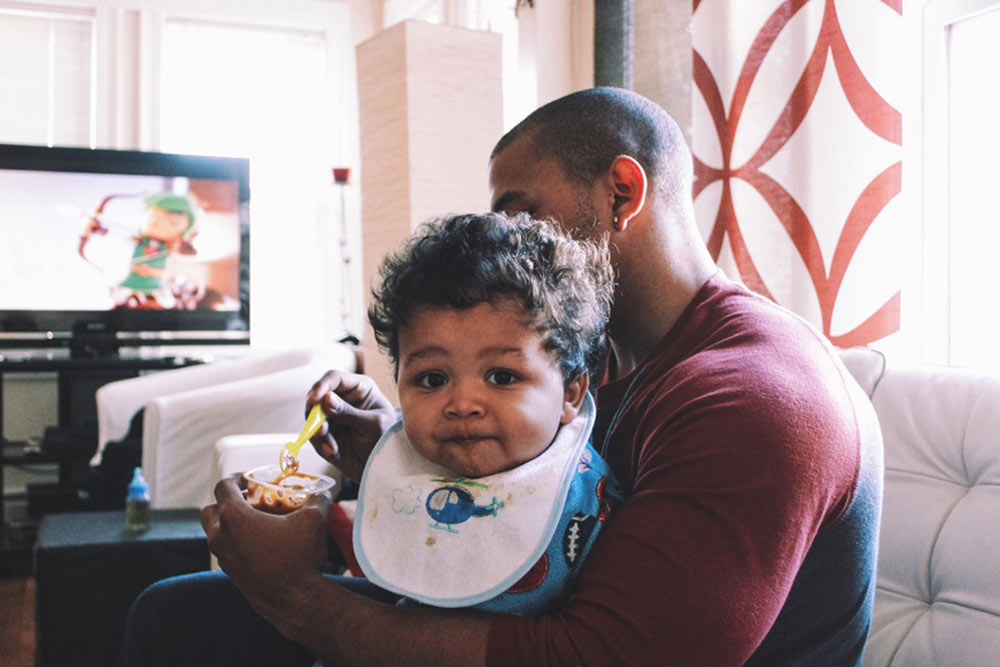When Should My Baby Start Solid Foods?

Does your tiny diner seem eager for more than milk? Here’s what you need to know before solidifying baby’s next meal.
Navigating a world beyond liquids with a newbie can seem like a daunting task for first-time parents. Questions abound: How do I gauge if the time is right for solids? Which baby foods do we try first? How much should my baby be eating a day? But introducing new tastes and textures doesn’t have to be complicated or stressful—the move toward meals your tyke can chew is a slow and steady process—and it can actually be a whole lot of fun. Below you’ll find answers to some of the most common queries about launching into lunchtime (and breakfast time, and dinnertime, and snack time…) with your little one.
How do I know my baby is ready for more than just breast milk or formula?
Watch your child’s cues and trust your instincts. Does your baby show an interest in your food? Does she watch and observe you as you eat? “A lot of children will literally reach out to the spoon as their parent is eating,” says Wendy Sue Swanson, MD, MBE, FAAP, author of Mama Doc Medicine: Finding Calm and Confidence in Child Health, Parenting, and World-Life Balance. “That’s a definite sign of early readiness to begin solids.”
Other milestones that indicate your child is progressing toward eating solid food include doubled birth weight, making cooing and laughing sounds, maintaining good head control, rolling, and sitting up assisted (which is necessary for using a highchair safely). Typically, these indicators happen between 4 and 6 months of age, but every baby is different. You know your baby best, so talk to your pediatrician about the right time for your kiddo to begin solids. “The bottom line: There’s no urgency and there’s no rush,” reassures Swanson. Respect your wee one’s response and don’t ever push foods through pursed lips, but keep offering when you think she’s ready. Eventually she’ll open up on her own for the next bite.
Which foods should I introduce first?
Though reconstituted rice cereal has long been suggested as an ideal first food due to its high iron content and easy-to-modify consistency, recent research suggests a reassessment is in order. “There have been reports about arsenic contamination in rice, and so it’s recommended that babies have baby cereal only once a week,” reports Swanson. Some baby food brands have made efforts to lower arsenic amounts in recent years, but experts say levels are still above what’s recommended, according Brian Ronholm, director of food policy at Consumer Reports.
But it’s not only rice cereal that contains elevated arsenic levels. Other rice products, like rice puffs and rice cakes, sweet potatoes, and apple and grape fruit juices are all higher-risk products for heavy metal exposure and should be limited.
Beyond that, the food selection you make for baby’s first foods is entirely up to you. “There is no research showing that there is one perfect single-ingredient food,” says Swanson. “You can choose peas, you can choose apricots, you can choose pears, you can choose apples, you can even choose puréed meat! What matters most is that you are allowing your baby to experiment with the feeling of food in her mouth at mealtime.”
How much should my baby be eating?
Again, let baby be your guide. Your job as a parent is to make sure you’re offering a variety of foods for her to try, and your baby’s job is to eat until she’s full and then know she can stop. “I’m a big believer in baby-led eating,” says Swanson. “Just like ours, babies’ appetites change from day to day. It’s really OK to follow their lead.” Some days your baby may eat a full jar of carrots, the next day she may eat one bite. The ability to accurately discern when your body is finished eating is an important skill to learn, and by letting your child accept food at her own pace, without pushing or demanding it of her, you’re helping to teach that skill.
Another approach to consider is the baby-led weaning method of self-feeding. This approach also involves adding complementary foods to baby’s diet of breast milk or formula, but the difference is pureed foods and spoon-feeding are skipped altogether. Instead, parents offer larger pieces of food, such as an avocado or a banana spear, a steamed broccoli floret, or a sardine filet from the can for their child to explore. It may sound risky, but research shows that babies who are started on finger foods are no more likely to choke than children who eat from a spoon. (In terms of food size, think big enough for baby to grab, but not small enough to place entirely in her mouth.)
Benefits of baby-led weaning include the development of critical motor and oral skills, the ability to practice swallowing, increased jaw strength, and most importantly, your child’s independence in enjoying a variety of foods while controlling what and how much she will eat.
Should I delay introducing certain foods because of allergy concerns?
There have been questions in the past about when to institute “high-allergy” foods such as peanuts, eggs and shellfish into baby’s diet. The consensus was that waiting until a child was older before giving her foods from these categories would lower her risk of developing food allergies. However, Swanson says that thinking has been disproven, and that it’s now believed that waiting on these foods may actually be more harmful.
Instead, Swanson encourages giving all foods on a regular timeline and watching your child’s response. But don’t jump right to serving omelets or spoonfuls of peanut butter to your 4-month-old. “We don’t want these allergenic foods to be last, but we don’t want them to be first either.” Sprinkle in foods considered “at-risk” as allergens at varying intervals along the way. Both the American Academy of Pediatrics (AAP) and the American Academy of Allergy, Asthma and Immunology recommend waiting three to five days between the introduction of new foods, in order to accurately gauge your child’s reaction to each specific food.







